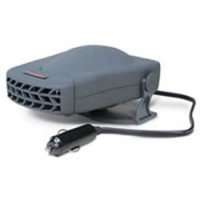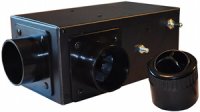Often times people will use 12 volt heaters in the car, truck or RV as a temporary solution when the factory heater in the vehicle stops functioning properly due to either a clogged heater core or a burned out heater blower motor.
There are a few things that you should know before you spend your hard earned money on just any heater. No matter which type of vehicle you plan to use the heater in you must make sure that
the 12 volt cigarette lighter socket can supply enough power. Power requirements will always be stated in amps.
In most cases the cigarette lighter socket in cars, trucks, RV’s and boats can only handle up to 10 amps. This means that if your new portable auto heater is designed to use more than 10 amps you will likely “blow” a fuse. While it is possible we do not recommend swapping the fuse in your fuse box for a larger fuse. There is a very good chance that the wiring leading to your 12V socket/outlet can only handle 10-amps of current.
The solution – Use a style of heater which makes use of direct hook up connections to the vehicle battery. These heaters generally produce more than twice the amount of heat as they are wired directly to the 12 volt battery so power is not restricted by vehicle accessory outlet wiring.
The RoadPro RPSL-681 is a Direct Hook-up Ceramic Auto Heater that comes with ring terminals already crimped and soldered onto the ends of the hook-up wires for easy installation. To properly route these wires to your battery in a car or RV the wires must be routed through your vehicle's firewall. Never run the wires out of the cab through the door as the wires can become damaged and will create a dangerous electrical short.
Vehicle Firewall wire routing – You will usually be able to find a rubber grommet in your vehicle's firewall be pulling back the interior carpet where the drivers or passengers feet would normally rest. An acceptable grommet would already have some wires running through it or it would be a blank (a grommet that fills a firewall hole with no wires currently running through it).
Simply run your heater's hook-up wires through an acceptable firewall grommet and properly route to the vehicle's battery. Once the wire run has been made be sure to secure all excess wiring using zip ties (wire ties). Make sure you do not fasten the auto heaters wires to any hot or moving parts in the motor compartment or inside the vehicle.
Semi Truck wire routing – truck drivers will usually be able to find a hole in the floor of their truck cab which was intended for wiring. You should wrap any exposed wires in split loom conduit to help protect wiring against excessive rubbing and wear due to vibration. Conduit also helps protect against the elements. Truckers should make sure that wires are not fastened to the truck cab and frame as the cab has a type of suspension which allows some movement independent from the truck frame which will damage the heater wiring. Secure only to one or the other and make sure to leave a little slack for your suspension.
Smaller non-direct wire heaters for use in your car, truck, RV or boat are great for a little heat for hands or feet when needed, but are best for defrosting the windows. These are intended for use in a small confined space and will work best in smaller vehicles. In very cold conditions it can take some time for these smaller heaters to start blowing a lot of heat. As the air temperature in the vehicle gets warmer the heater will be able to produce more heat. This is due to the design of these small portable heaters. Air is pulled in through the rear or side and then moves across a heating element before exiting the front of the heater. Cooler intake air causes lower output temps. Warmer intake air produces warmer output temps.
Heater Power Consumption
12 Volt Heaters that plug into the lighter socket outlet will draw 10 amps or less. Heaters that require direct battery wiring tend to draw a lot more power. You can expect a direct hook-up heater to draw significantly more power. These heaters will consume anywhere from 20 to 50 amps of DC power.
It's never a good idea to run a 12 volt heater without the vehicle's engine running to keep the battery charged up. If you're trying to keep warm while also conserving fuel you should start the vehicle's engine at least twice an hour letting it run for a minimum of 10 minutes so that the alternator may replenish battery reserves.